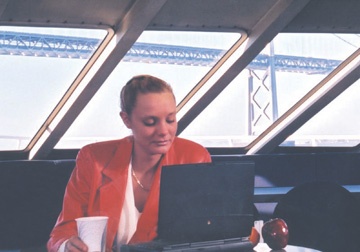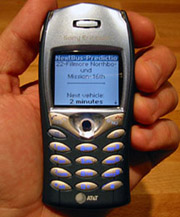
Tick Tock on the Dock–Harnessing High
Tech for Bay Area Ferry Customers
 |
| Ferry users
will soon be able to download real time ferry
schedules from their computers to their PDAs |
Pop artists Tom Petty and the
Heartbreakers must have had public transit in mind when
crooning, “The waiting is the hardest part.” Indeed, the
experience of not knowing when your bus, train, or ferry
will arrive can be quite stressful. But, ferry customers’
anxieties may soon be relieved thanks to new technology that
the San Francisco Bay Area Water Transit Authority (WTA)
plans to introduce with the help of other Bay Area ferry
operators.
About Time—for Real Time
At its March 24, 2005 meeting, the WTA Board selected
NextBus to provide real time equipment, software, signage,
and installation services. WTA Director Marina Secchitano
enthusiastically voted for the contract and said: “It’s
about time we get new signs in at these terminals. It is
long overdue.” The project includes designing a kiosk at the
Ferry Building that patrons can access for trip planning,
fare, and other service information. Assuming approvals from
the Golden Gate Bridge Highway and Transit District (GGBHTD)
Board, Port of San Francisco, and Bay Conservation and
Development Commission (BCDC), NextBus could start working
on implementing service as early as Summer 2005.
The WTA would purchase this system and
would first install it within the Golden Gate and Vallejo
ferry services. Eventually, WTA would extend the system to
the Alameda/Oakland ferry service. The WTA will use funds
from new bridge tolls to pay for this program Jim Swindler,
from the Golden Gate Ferry service, said, “We’re looking
forward to working with the WTA on this project because we
see the benefit it brings to our passengers. Our passengers
rely on our convenient and reliable services and by adding
real time information they will be able to take advantage of
this new technology.”
 |
| NextBus
allows transit riders to access schedules via
cell phone |
Ferry Riders Get Wired
Public transit agencies have been using real time systems to
inform customers of the next arrival time of buses and
trains since at least the early 1990s.
Vallejo Baylink has been using Light
Emitting Diode (LED) message boards at their ferry
terminal in Vallejo for two years now. Apart from
announcing the ferry schedule, they use it to tell people
about delays and service disruptions, special
events, security threat levels, and to provide reminders
concerning ferry service policies and procedures.
Vallejo Baylink Ferry Service General
Manager Marty Robbins said, “Having the message board has
been like adding another customer service employee, but one
that is available for duty 24/7. But, if we had actual real
time information, customers wouldn’t need to come to the
terminal to know when their next vessel is arriving: they
would be able to remotely access the information via
computer, handheld device, or telephone. When a ferry is
late or schedules change, our passengers would like to know
so they can plan to spend their time more enjoyably than
just sitting around the terminal.”
Coast to Coast
In a New York Minute
NextBus has installed, and currently operates, information
systems for more than 30 public transit agencies throughout
the country, including New York City Water Taxi Co.
Tom Fox, president of New York Water Taxi, said that NextBus
has brought a “variety of benefits. We can tell where any of
our boats are at any time and can let passengers know. The
worst thing to do with a ferry service would be to leave the
dock early–with this system, we can hold captains
accountable. The real time information LEDs, which we expect
to have up by summer, will make an unfamiliar place [the
waterfront] comfortable for the public. It promotes ease of
use and may even reduce instances of ‘trip and falls’
because people won’t be unnecessarily running for the boat
[if they can tell the exact time that it will arrive]. We
decided to use it because it works; and, anecdotally, people
like the service.”
Mr. Fox predicted that it would be a boon
to making transit connections and give office workers near
the downtown San Francisco terminal enough advance warning
that they could easily leave their computers in time to walk
to the terminal and catch their boat. He said that New York
Water Taxi’s real time information has been added to the
plasma display in one large Brooklyn office building’s
elevator. Along with bulletins such as news, time, and
weather, this display now lets people know the arrival time
for the next ferry at their neighborhood pier.
 |
| Golden Gate
Ferry, working with WTA,, would be among the
first operators to offer real time information |
On the West Coast
In the San Francisco Bay Area, two major bus services use
real time information systems: San Francisco MUNI and the
East Bay’s AC Transit. According to John Rudniski, Director
of Maintenance for AC Transit, their bus service switched
from a radio dispatch system to an Automatic Vehicle Locator
(AVL) and Computer-Aided Dispatch (CAD) run through GPS in
2002. They are still phasing in other features and refining
it and have linked their system to a few LED displays placed
at heavily trafficked bus stops.
Mr. Rudniski said that their system is
similar to air traffic control, allowing their operations
division to view the entire district and watch individual
buses as they proceed on their route. “It is a more
efficient way to manage our fleet, thus making more reliable
service for our passengers.” He added that it has enhanced
the emergency response capabilities too. “We now know the
exact location of a bus [in distress] and can send help
immediately.”
 |
| WTA will
work with the Port of SF and BCDC on new message
boards at gates displaying arrival of next ferry |
Steve Castleberry, WTA’s CEO, explained
that existing Bay Area ferry technology already monitors the
exact location of each boat, but this project will add GPS
technology that will enable the vessels to communicate with
the message boards on the docks. He said, “One of the best
things about real time information is that transit operators
can individually tailor it to their service.” Mr.
Castleberry added that he is very excited about developing
trip planning technology for the ferry system enabling ferry
passengers to get schedules from their PDAs or cell phones.
“Passengers will have all of the ferry schedules in one
convenient location–all in the palm of their hand.” This
type of trip planning technology, accessible on www.bart.gov,
is very popular with BART customers, which reports 654,000
registered users and approximately 150,000 total users.